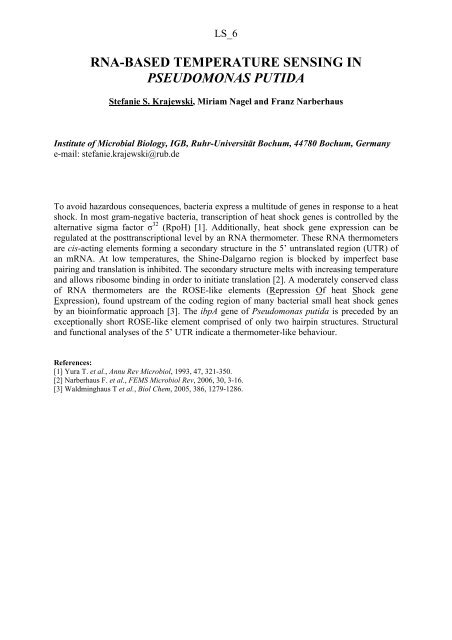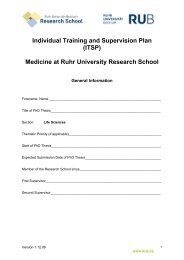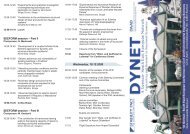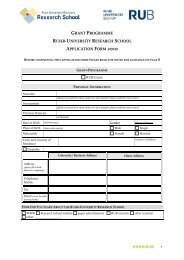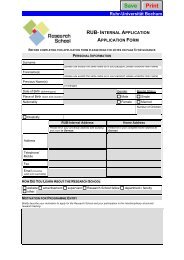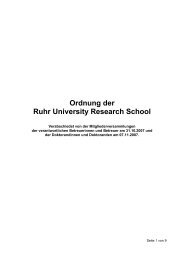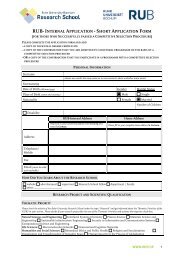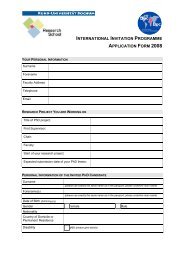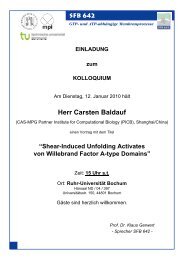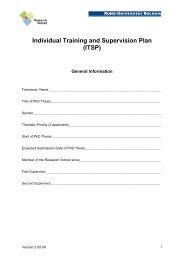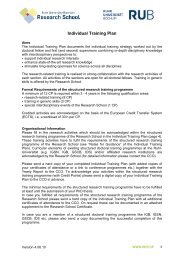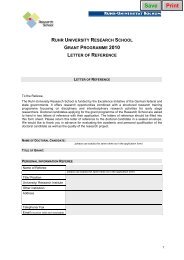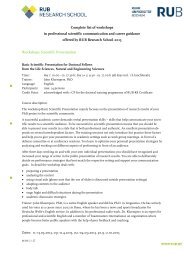Section Days abstract book 2010.indd - RUB Research School ...
Section Days abstract book 2010.indd - RUB Research School ...
Section Days abstract book 2010.indd - RUB Research School ...
Create successful ePaper yourself
Turn your PDF publications into a flip-book with our unique Google optimized e-Paper software.
LS_6<br />
RNA-BASED TEMPERATURE SENSING IN<br />
PSEUDOMONAS PUTIDA<br />
Stefanie S. Krajewski, Miriam Nagel and Franz Narberhaus<br />
Institute of Microbial Biology, IGB, Ruhr-Universität Bochum, 44780 Bochum, Germany<br />
e-mail: stefanie.krajewski@rub.de<br />
To avoid hazardous consequences, bacteria express a multitude of genes in response to a heat<br />
shock. In most gram-negative bacteria, transcription of heat shock genes is controlled by the<br />
alternative sigma factor σ 32 (RpoH) [1]. Additionally, heat shock gene expression can be<br />
regulated at the posttranscriptional level by an RNA thermometer. These RNA thermometers<br />
are cis-acting elements forming a secondary structure in the 5’ untranslated region (UTR) of<br />
an mRNA. At low temperatures, the Shine-Dalgarno region is blocked by imperfect base<br />
pairing and translation is inhibited. The secondary structure melts with increasing temperature<br />
and allows ribosome binding in order to initiate translation [2]. A moderately conserved class<br />
of RNA thermometers are the ROSE-like elements (Repression Of heat Shock gene<br />
Expression), found upstream of the coding region of many bacterial small heat shock genes<br />
by an bioinformatic approach [3]. The ibpA gene of Pseudomonas putida is preceded by an<br />
exceptionally short ROSE-like element comprised of only two hairpin structures. Structural<br />
and functional analyses of the 5’ UTR indicate a thermometer-like behaviour.<br />
References:<br />
[1] Yura T. et al., Annu Rev Microbiol, 1993, 47, 321-350.<br />
[2] Narberhaus F. et al., FEMS Microbiol Rev, 2006, 30, 3-16.<br />
[3] Waldminghaus T et al., Biol Chem, 2005, 386, 1279-1286.


